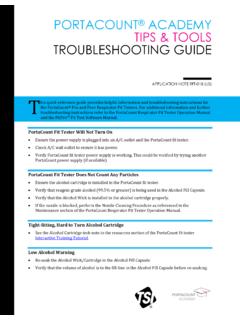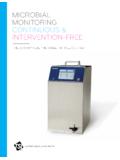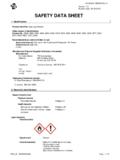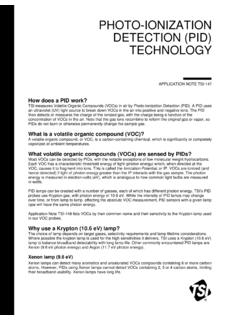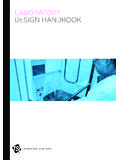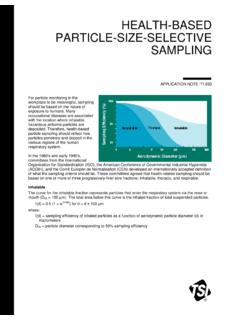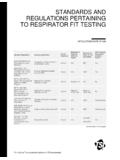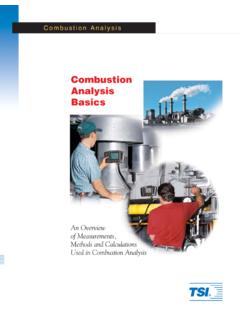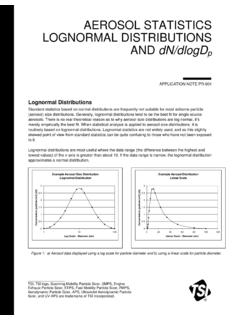Transcription of How to measure pressure - TSI
1 how to measure pressure HOW TO measure FLOW by Airflow Developments Limited how to measure pressure . FUNDAMENTAL PRINCIPLES. Due to the depth of the earth s atmosphere the air around us exerts a pressure , known as atmospheric pressure . This can be measured with a barometer and varies depending upon the weather conditions. It also varies according to altitude above or below sea level at which it is made. pressure measurements in heating systems are usually made relative to atmospheric pressure , and may be corrected to Standard Conditions to make possible a comparison between readings. The internationally agreed Standard Conditions are for an air density of kg/m.
2 ( Atmospheric air at a temperature of 16 C, a pressure of 100,000 Pa. and a relative humidity of 65% has a density of kg/m , but these conditions are not part of the definition.) The only pressure acting at any point in a stationary fluid is Hydrostatic pressure which acts equally in all directions. If the fluid is set in motion the pressure still persists, but may change in magnitude. If we consider a very thin disc placed in the fluid, and moving with it, the static pressure as it is called will act on the two faces of the disc. INFINITELY THIN DISC. PSPS 2 If the disc is stationary the pressure acting on the two surfaces will be the same providing the presence of the disc does not disturb the flow.
3 NO DISTURBANCE PSPSPS However if the stationary disc is turned through 90 its front face will be subjected to not only static pressure , but also an additional dynamic pressure equal to the velocity pressure in incompressible flow, due to the impact. PDVPD = x x V = DENSITY OF THE FLUID 3 The velocity pressure is due entirely to the motion of the flow and depends upon the velocity and the density of the fluid. The algebraic sum of the static pressure and the velocity pressure is called the total pressure . MEASURING TOTAL AND STATIC pressure . A tube placed in a duct facing into the direction of the flow will measure the total pressure in the duct.
4 If frictional losses are neglected, the mean total pressure at any cross section throughout the duct system is constant. Static pressure can only be determined accurately by measuring it in a manner such that the velocity pressure has no influence on the measurement at all. This is carried out by measuring it through a small hole at the wall of the duct; or a series of holes positioned at right angles to the flow in a surface lying parallel to the lines of flow. The pitot static tube is an example of this. Figure 1 shows the principle of the pitot static tube. Figure 1. Principle of the pitot static tube. 4 It will be seen that connecting tubes to a manometer makes the measurement of pressure .
5 INSTRUMENTS FOR MEASURING pressure . [1]. U TUBE MANOMETER. Although probably the oldest method of measuring low pressures, the simple U tube has much to commend it. If a U shaped glass tube is half filled with a liquid, water, and a pressure is applied to one end of the limb, the other being open to atmosphere, the liquid will move to balance the pressure . The weight of liquid so displaced will be proportional to the pressure applied. As the difference in height of the two columns of liquid and the density are known the pressure can be calculated. Each millimetre height difference of water column represents approximately 10 Pascals. Figure 2.
6 Principle of the U-tube manometer. A disadvantage of the U tube is that the scale has to be constantly moved to line up with the moving zero 5 Alternatively with zero taken at the centre point the scale length is halved with subsequent loss of resolution. [2]. LIQUID - IN GLASS MANOMETERS. The disadvantages of the simple U tube manometer are overcome and other advantages incorporated in single limb industrial manometers in which it is only necessary to read one liquid level. In one such design, one of the limbs of the U tube is replaced by a reservoir, thus substantially increasing the surface area. A pressure applied to this reservoir causes the level of fluid to move a small, calculable amount.
7 The same volume of fluid displaced in the glass limb produces a considerable change in the level. This nearly doubles the resolution compared with the U tube manometer for vertical instruments and gives much greater magnification when the limb is inclined. The manometer fluid may be plain water, but problems can arise from algae growing in the tube causing the density of the fluid to alter. Special blends of paraffin are often used and these have several advantages: a free moving meniscus, no staining of the tube, and expanded scales due to low relative densities. Where higher pressures are required, denser fluids are used, of which mercury is often used.
8 For very low pressures the manometer limb is inclined to improve the resolution further. More precision can be achieved with adjustable - range limbs and it is possible to achieve from 0 - 125 Pa. to 0 - 5000 Pa. with only two limbs. Figure 4: Examples of Single Limb Manometers 6 Figure 3. Precision portable manometer set. [3]. DIAL GAUGES. Dial pressure gauges are primarily employed for reading high pressures. At very low pressures they tend to exhibit unacceptable hysteresis errors unless they are very high quality instruments. Due to short scale length, the resolution is not usually very good. [4]. pressure TRANSDUCERS. As an alternative to the fundamental liquid - filled portable manometer, electronic pressure transducer based instruments are available for laboratory or site use.
9 They are generally compact as to be hand held, and eliminate the use of fluids, giving an acceptable level of accuracy for normal ventilating and related air movement measurement. The capacitance transducer employs a precision diaphragm moving between fixed electrodes. This causes capacitance changes proportional to a differential pressure . 7 The piezo resistive pressure sensor contains a silicon chip with an integral sensing diaphragm and four piezo-resistors; pressure applied on the diaphragm causes it to flex changing the resistance; this causes a low level output voltage proportional to pressure . A pressure transducer - based instrument allows continuous monitoring using a recorder, or input to electronic storage or control equipment.
10 Figure 6. Pocket Manometer DB2. Microprocessor technology allows for the pressure readings to be converted into velocity readings when using a pitot static tube. In some instances the probe calibration factor may be inputted separately allowing other pressure measuring probes to be used with direct velocity readout. Several readings can be stored, with MIN, MAX and AVE functions. In some instances, duct area can be inputted to allow direct volume flow measurement 8 Figure 7. Airflow MEDM 5k Micromanometer. 9 Figure 8. PVM100 Micromanometer. 10 HOW TO measure VOLUME FLOW RATE.
